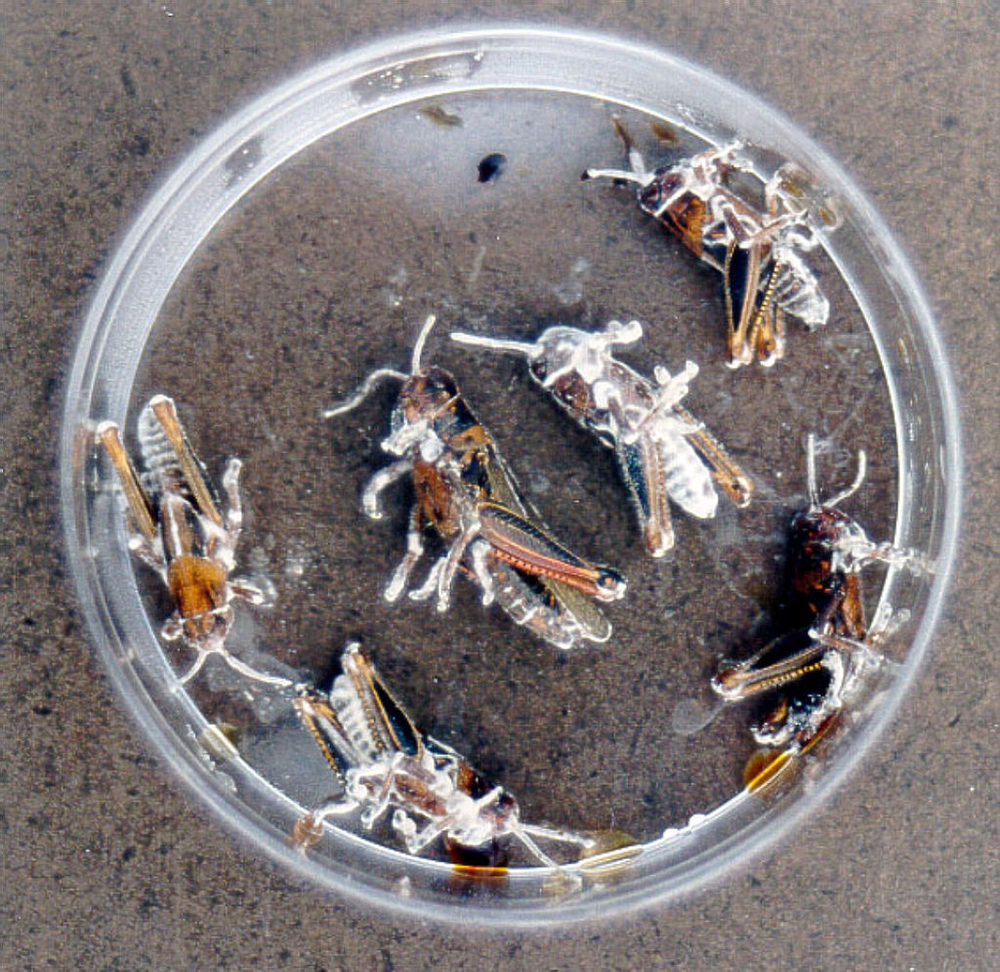Microbial products are products derived from various microscopic organisms.
Microbial products may consist of the organisms themselves and/or the metabolites they produce.
Microbial products are generally divided into six different subcategories of products:

Bacteria
Biologicals based on bacteria have been used to control plant diseases, nematodes, insects, and weeds. Bacteria are present in all soils and are the most abundant micro-organisms in soil samples. Many spore forming and non-spore forming bacteria are known to be effective against a wide spectrum of insects and diseases.
The most well-known and widely used of all biologicals are insecticides based on Bacillus thuringiensis, commonly referred to as “Bt.” During spore formation, Bt produces insecticidal proteins (know as delta-endotoxins) that kill caterpillar pests, fly and mosquito larvae, or beetles (depending on the subspecies and strain of Bt) that ingest them through feeding in Bt-treated areas. The highly specific delta-endotoxins bind to and destroy the cellular lining of the insect digestive tract, causing the insect to stop feeding and die. Bt has been in continuous commercial use for over 50 years, a record not exceeded by any other insecticide active ingredient. Bacillus sphaericus is another insecticidal bacterium that has been used successfully to control certain mosquito species.
Other bacteria are used for the control of plant pathogens. Certain strains of Bacillus subtilis, Bacillus pumilus, Pseudomonas spp., and Streptomyces spp. increase yield and prevent plant diseases by outcompeting plant pathogens in the rhizosphere, producing anti-fungal compounds, and by promoting plant and root growth.
Fungi
Different fungal biologicals can be used to control plant diseases (caused by other fungi, bacteria or nematodes), as well as some insect pests and weeds. Fungi are a diverse group of organisms and can be found in almost every environment on Earth. Most have complex lifecycles, and some are parasitic to various eukaryotes, including plants and insects. Some species have proven useful as microbial biologicals. However, because they are living organisms, they do require specific environmental conditions to proliferate. Because fungal biologicals are so diverse in nature, their means of affecting the target pest can be equally diverse. The most common modes of action are through competitive exclusion, mycoparasitism, and production of metabolites. Some fungi can exhibit all of these modes of action. Two of the most common commercial fungal biologicals are Trichoderma spp. and Beauveria bassiana. Each are frequently used in the nursery, ornamental, vegetable, field crop, and forestry industries to control a variety of pests.Trichoderma spp. are some of the most common fungi in nature. Many beneficial Trichoderma have the ability to readily colonize plant roots, without harming the plant. It is this close relationship with the plant that make these species excellent biocontrol agents. These microbial biofungicides can out-compete pathogenic fungi for food and space, and in the process can stimulate plant host defenses and affect root growth. In addition, they have the ability to attack and parasitize plant pathogens under certain environmental conditions.
Beauveria bassiana is a fungus that acts as a parasite on many insect species. B. bassiana has a broad host range, although individual strains may be restricted in the number of insects it can attack. B. bassiana spores adhere directly to the host cuticle, where they will germinate, produce enzymes that attack and dissolve the cuticle, penetrate, and grow into the insect’s body, feeding on internal tissues and releasing an insect toxin. As the insect dies, it changes color to pink or brown and eventually the entire body cavity is filled with fungal mass. B. bassiana has proved effective in controlling troublesome crop pests such as aphids, thrips and whitefly – even chemical pesticide-resistant strains such as Q-Biotype Whitefly.
Protozoa
Protozoa are single-celled eukaryotic organisms that exist in both water and soil. While most protozoa feed on bacteria and decaying organic matter, a wide range of protozoan species are insect parasites.
For example, the protozan Nosema locustae is known to be a natural biocontrol agent of many grasshopper species. Nosema infects at least 90 species of grasshoppers. It is non-toxic to humans and other mammals, as well as the over 250 natural predators of grasshoppers. Nosema is particularly important in areas where environmental issues preclude use of traditional insecticides.
Grasshoppers cause millions of dollars of damage to forage crops each year. Nosema locustae has been developed into a commercially available grasshopper control agent that infects and weakens young grasshoppers and adversely affects female grasshoppers’ ability to reproduce.
After consuming Nosema locustae, grasshopper feeding is typically curtailed within a week. Within two weeks or longer, as many as 50% of the infected insects die and approximately half of the surviving population remains weak, consuming 75% less forage than a healthy insect.
Grasshoppers are notorious scavengers. An important function in the transmission of Nosema spores to healthy grasshoppers occurs as the insects scavenge and cannibalize infected cadavers. Since infected grasshoppers develop a large number of the spores within them, the cannibalizing grasshoppers get a much greater dose of the disease causing organism than through the initial Nosema application.
Viruses
Microbial biologicals known as baculoviruses are a family of naturally-occurring viruses known to infect only insects and some related arthropods. Most are so specific in their action that they infect and kill only one or a few species of Lepidoptera larvae (caterpillars), making them good candidates for management of crop pests with minimal off-target effects.
Baculoviruses used as microbial biologicals consist of DNA surrounded by a protein coat (nucleocapsid), which is itself embedded in a protein “microcapsule” or occlusion body (OB) that provides some protection from degradation in the environment. Depending on the virus, OBs may contain a single nucleocapsid (a granulovirus, or GV) or multiple nucleocapsids (nucleopolyhedrovirus, or NPV).
Upon ingestion by a susceptible caterpillar, OBs are dissolved within the alkaline midgut, releasing nucleocapsids that infect the cells lining the midgut. The viral DNA replicates in the nuclei of the host cells and then spreads throughout the body of the larvae, essentially turning it into a “virus factory.” The infected insect stops feeding within a few days, dies and disintegrates, releasing billions of new OBs which can be ingested and cause new infection of neighboring larvae.
The granulovirus of the codling moth Cydia pomonella, or CpGV, is a good example of a commercially successful viral insecticide. First discovered in the 1960 s, it is now the active ingredient of about a half-dozen products sold worldwide. Often used in conjunction pheromone-based mating disruption, CpGV limits codling moth populations and damage in pome fruits while preserving beneficial insects and minimizing chemical residues. Although accepted for use in organic farming, most CpGV applications occur in conventional orchards where its unique mode of action can minimize risk of resistance to chemical insecticides.
Yeast
A variety of yeasts have been investigated for their usefulness in controlling plant diseases. Non-pathogenic Cryptococcus and Candida species naturally occur on plant tissues and in water. Isolates from a variety of crops have been investigated for their biocontrol capacities.For example, Candida oleophila Strain O, first isolated from golden delicious apples, has been developed into an effective biocontrols for the control of post-harvest fruit rots. It is applied to apples and pears after harvest — but before storage — to control particular fungal pathogens. The yeast serves as an antagonist to fungal pathogens such as gray mold (Botrytis cinerea) and blue mold (Penicillium expansum), which cause post-harvest decay.
Candida oleophila Strain O works primarily through competition for nutrients and pre-colonization of plant wound sites. However, there is evidence that it produces enzymes that can degrade fungal cell walls and stimulate plant host defense pathways in freshly harvested fruit, both of which may also make a restricted contribution to the strain’s antagonistic activity.
